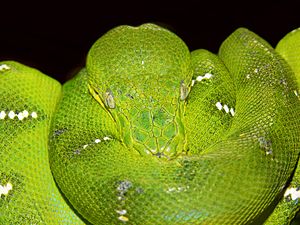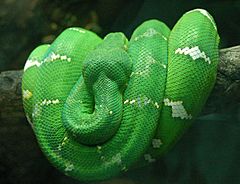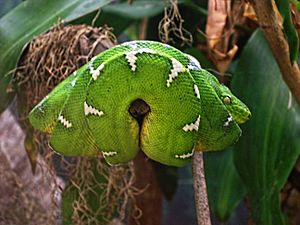Emerald tree boa facts for kids
Quick facts for kids Emerald tree boa |
|
|---|---|
 |
|
| Conservation status | |
| Scientific classification | |
| Genus: |
Corallus
|
| Species: |
caninus
|
The emerald tree boa (Corallus caninus) is a beautiful snake. It lives in the rainforests of South America. This snake is a type of boa. Like all boas, it is not venomous. Since 2009, a similar snake called Corallus batesii has been identified as a different species.
Contents
What the Emerald Tree Boa Looks Like
These snakes can grow to about 6 feet (1.8 meters) long. They have very long front teeth. These teeth are bigger than those of most other non-venomous snakes.
Their main color is a bright emerald green. They have a white, zigzag stripe down their back. This stripe often looks like 'lightning bolts'. Their belly is usually yellow. This bright green color and unique markings make them stand out among South American snakes.
Young emerald tree boas are different colors. They can be light or dark orange, or even brick-red. After about 9 to 12 months, they slowly change color. They turn into the beautiful emerald green color of the adults.
This color change also happens in the green tree python (Morelia viridis). Green tree python babies can also be yellow or brick-red. However, emerald tree boa babies are never yellow.
Some scientists think there might be different types of emerald tree boas. They might even be new species. One suggested name for a different type is Corallus batesii.
Snakes from the Amazon River basin tend to be larger. They can grow to 7–9 feet (2.1–2.7 meters). They are also often calmer than their relatives from the north. The average size for all emerald tree boas is closer to 6 feet. Snakes from Peru, in the southern part of their range, often have darker colors.
Amazon Basin boas usually have one long, unbroken white line on their back. But boas from Guyana and Suriname have white markings that vary a lot. The scales on the snout of Amazon Basin boas are also much smaller. This is different from boas found in places like Suriname, Venezuela, Bolivia, and French Guiana. Sometimes, different types of these boas can even mix and have babies.
The emerald tree boa looks very much like the southern green tree python. The green tree python lives in southeast Asia and Australia. This is an example of convergent evolution. This means two different species develop similar traits because they live in similar environments. Even though they look alike, these two snake species are only distantly related. You can tell them apart by looking at the scales on their heads. Also, the heat pits around their mouths are in different places.
Where the Emerald Tree Boa Lives
You can find the emerald tree boa in South America. They live in the northern parts of Colombia, Brazil, and from Venezuela to Suriname and the Guianas. This area is known as the Guiana Shield.
The 'Basin' type of emerald tree boa lives only along the Amazon River basin. This includes southern Suriname, southern Guiana, southern Venezuela, Colombia, Peru, and Brazil. They live in the jungles around the Amazon River.
What the Emerald Tree Boa Eats
Emerald tree boas mainly eat small mammals. But they have also been seen eating smaller birds, lizards, and frogs. These snakes have a very slow metabolism. This means they don't need to eat as often as snakes that live on the ground. They might only eat once every few months.
People used to think that these boas mostly ate birds. However, studies have looked at what's inside their stomachs. These studies show that most of their diet is small mammals. This includes animals like rodents and marsupials. Young boas and newborns have also been seen eating small lizards and frogs. They especially like glass frogs.
Reproduction and Life Cycle
The emerald tree boa is ovoviviparous. This means the mother carries the eggs inside her body. The babies hatch inside her and then are born live. Females usually have between 6 and 14 babies at a time. It's very rare for them to have more than that.
Newly born babies are a distinct brick-red or orange color. Over about 12 months, they slowly change color. They gradually turn into the full emerald green color of the adult snakes.
See also
 In Spanish: Boa Esmeralda para niños
In Spanish: Boa Esmeralda para niños




